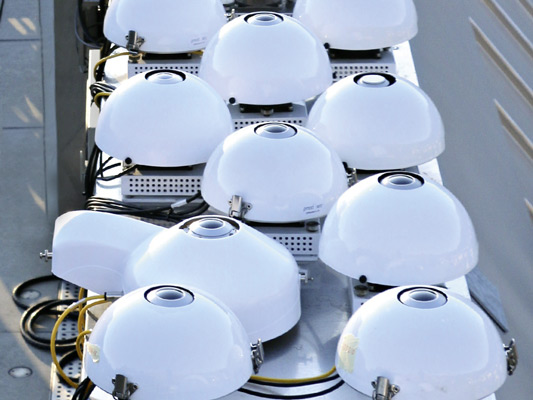The Earth’s surface radiation budget plays a crucial role in the climate system, and accurately characterising components of the radiation budget is therefore an important task. The Baseline Surface Radiation Network (BSRN; e.g. Driemel et al., 2018) is one of several international networks to coordinate the measurement and archiving of radiation data. On a national level, MeteoSwiss conducts radiation measurements at 4 stations following similar BSRN guidelines.
Longwave radiation measurements are conducted with pyrgeometers traceable to the World Infrared Standard Group (WISG) at PMOD/WRC, Davos. However, several important aspects concerning the traceability of the WISG and hence MeteoSwiss and BSRN archives remain to be resolved by the research community (Gröbner et al., 2014; Nyeki et al., 2017; and references therein). In order to address these issues, a WMO CIMO Task Team on Radiation References recently published their recommendations (CIMO, 2018).
Extending the Calibration Traceability of Longwave Radiation Time-Series (ExTrac) in MeteoSwiss and BSRN Archives
The ExTrac project aimed to define methods and procedures to re-calculate longwave radiation time-series (or parts thereof) in the BSRN archive and thereby demonstrate how traceability to the WISG and SI could be achieved for these historical datasets. This will benefit the BSRN and GCOS community by helping to:
i) Define methodologies to reduce uncertainties in the traceability of radiation budget studies which use the BSRN archive for climate models and to validate satellite data (e.g. Wild et al., 2016; and references therein). GCOS guidelines for data submission state that data should be traceable.
ii) Accurately monitor the trends in observed longwave radiation at the surface.
iii) Prevent the loss of legacy data and ensure their availability for future use when traceability and instrumental issues (e.g. CIMO, 2018) have been resolved.
ExTrac focussed on the above traceability and instrumental issues. Priorities 1.4, 1.6 and 2.3 of the GCOS Switzerland Strategy 2017 – 2026 were addressed.
Work Packages
Work Package 1: The pyrgeometers used at the Meteoswiss Payerne BSRN site to measure the atmospheric longwave irradiance over the last 20 years will be calibrated at PMOD/WRC in order to provide traceability to the WISG and to SI units, as strived by GCOS. Up to 2 BSRN sites chosen in WP3 will be contacted to send their pyrgeometers to PMOD/WRC for a calibration in order to reprocess their atmospheric longwave irradiance with traceability to the WISG. WP1 constitutes the major in-kind contribution of PMOD/WRC to this project.
Work Package 2: Methods and procedures will be developed to allow the re-calculation of atmospheric longwave irradiances from the BSRN archive using ancillary meteorological data archives or assimilated datasets such as ERA40 for atmospheric air temperature and humidity as proxys. The methods will be validated by using the pyrgeometer raw data from the Meteoswiss BSRN site re-covered from the MeteoSwiss archives together with the calibrations performed in WP1.
Work Package 3: The methodology developed in WP2 will be applied to key datasets from the BSRN archive for which traceable calibrations to the WISG either exist or for pyrgeometers recalibrated in WP1, to demonstrate the procedure to the BSRN community.
Work Package 4: We will attend the next BSRN workshop and inform the radiation research community about our plans. Final project results will be presented at the following BSRN workshop in summer 2022. Central to the above activities will be the close collaboration with the CIMO Task Team on Radiation References. A guideline document describing how to re-analyse BSRN datasets to provide traceability to the WISG and SI units will be written and submitted as a WMO CIMO document.
Documents:
Project Duration:
1. Aug. 2020 – 31. Jul. 2022
Financial Support for the ExTrac Project
Financial support by MeteoSwiss in the framework of GCOS Switzerland.
Finanzielle Unterstützung durch MeteoSchweiz im Rahmen von GCOS Schweiz.

